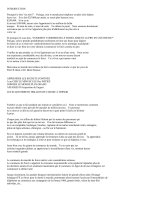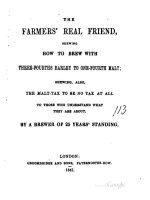How to Trade with Price Action Master. Galen Woods (File gốc)
Bạn đang xem bản rút gọn của tài liệu. Xem và tải ngay bản đầy đủ của tài liệu tại đây (3.49 MB, 82 trang )
›Raoixc sr›uPs RrrirW
RA
MASTER
G A L E H
W 0 0 D S
I
How to Trade with Price
Action (Master)
Trading Tools, Tips & Methods
Galen Woods
©2014 Galen Woods
Contents
Notices & Disclaimers . . . . . . . . . . . . . . . . . . . . .
i
Introduction.......................................................................iv
1. Looking Inside the Inside Bar for Day Trading.........1
1.1 Control Benchmark - Inside Bar.....................................2
1.2 Relative Volume of Inside Bar........................................2
1.3 Relative Range of Inside Bar..........................................3
1.4 Open-to-close Spread of Inside Bar...............................3
1.5 Bull or Bear Inside Bar...................................................4
1.6 What Is Inside The Inside Bar?......................................5
2. 10 Types of Price Charts for Trading..........................7
2.1 Line Charts......................................................................8
2.2 Bar Charts.....................................................................10
2.3 Candlestick Charts........................................................12
2.4 Volume Charts...............................................................14
2.5 Tick Charts....................................................................16
2.6 Range Bar Charts..........................................................19
2.7 Point & Figure (P&F) Charts.......................................20
2.8 Renko Charts.................................................................23
2.9 Kagi Charts...................................................................24
2.10 Three-Line Break Charts..............................................26
2.11 What’s Next?.................................................................28
3. 4 Price Action Methods to Define the Intraday Trend:
Part I..............................................................................30
3.1 Moving Average with Price Action..............................30
3.2 Price Channel with Price Action...................................33
3.3 Finding the Intraday Trend - A Comparison.................34
4. 4 Price Action Methods to Define the Intraday Trend:
Part II.............................................................................35
4.1 Higher Time-Frames.....................................................35
4.2 Trend Line......................................................................37
4.3 The Best Method for Finding Intraday Trend...............37
5. Day Trading With Only The 20-Period Moving Average 39
5.1 Using Moving Average For Market Context Analysis 39
5.2 Moving Average Day Trading Setups...........................41
5.3 Trade Management........................................................42
5.4 Conclusion: Day Trading with Moving Average..........42
6. How to Enter the Market as a Price Action Trader.......44
6.1 Common Trading Order Types.....................................44
6.2 Price Action Trading Entry Techniques........................45
6.3 More Considerations for Price Action Entries.............49
7. 4 Trading Strategies That Profit From Trapped Traders 50
7.1 Two Types of Trapped Traders......................................50
7.2 Day Trading Strategies With Trapped Traders.............51
7.3 Conclusion - Traders’ Trap............................................54
8. Forex Price Action Re-Entry Trading Strategy..................56
8.1 Trading Rules - Forex Price Action Re-Entry..............57
8.2 Forex Price Action Re-Entry Trading Examples..........58
8.3 Review - Forex Price Action Re-Entry Trading Strategy..................................................................................61
9. Price Action Trading Tips from the Reminiscences of
a Stock Operator.............................................................62
CONTENTS
9.1
9.2
9.3
9.4
9.5
9.6
Price Action Tip - Start with the Broad Market Trend 62
Price Action Tip - Aim to Trade Large Impulse Swings 63
Price Action Tip - Understand the Difference between Trend and Timing................................................64
Price Action Tip - Do not Overtrade.............................64
Price Action Tip - Avoid Reversal Trades....................65
Learn more about Price Action Trading from Jesse
Livermore......................................................................65
10........................................................................................3 Useful Tips
for Intraday Price Action Trading..................................66
10.1 Avoid Tight Congestion................................................66
10.2 Use Narrow Range Bars to Limit Risk.........................68
10.3 Do Not Go Against Price Momentum..........................69
10.4 Stay Out Of Trouble With These Intraday Price
Action Trading Tips.......................................................71
11.What’s Next?...................................................................72
11.1 How to Trade with Price Action (eBooks)....................72
11.2 How to Trade with Price Action (Online).....................72
11.3 Day Trading with Price Action Self-Study Course . 73
Notices & Disclaimers
Copyright © 2014 by Galen Woods (Singapore Business
Registration No. 53269377M). All rights reserved.
First Edition, October 2014.
Published by Galen Woods (Singapore Business Registration No.
53269377M).
All charts were created with NinjaTrader™. NinjaTrader™ is a
Registered Trademark of NinjaTrader™, LLC. All rights
reserved.
No part of this publication may be reproduced or transmitted in
any form or by any means, electronic or mechanical, without
written permission from the publisher, except as permitted by
Singapore Copyright Laws.
Contact Information
Galen Woods can be reached at:
• Website:
• Email:
Financial Disclaimer
Trading is risky. Please consult with your financial adviser before
making any trading or investment decision.
The information contained within this book including e-mail
trans- missions, faxes, recorded voice messages, and any other
associated content (hereinafter collectively referred to as
“Information”) is
Notices &
Disclaimers
ii
provided for informational and educational purposes only. The
Information should not be construed as investment/trading
advice and is not meant to be a solicitation or recommendation to
buy, sell, or hold any securities mentioned.
Neither Trading Setups Review nor Galen Woods (including all
con- tent contributors) is licensed by or registered with any
regulating body that allows us to give financial and investment
advice.
Trading Setups Review and Galen Woods makes no claim
regarding past or future performance. While there is always a
risk a loss when considering potential for profits. Losses
connected with trading futures contracts or other leveraged
instruments can be significant. Hence, you should consider if
such trading is suitable for you
in light of you financial
circumstances bearing in mind that all speculative trading is
risky and you should only speculate if you have sufficient risk
capital.
Trading Setups Review and Galen Woods does not manage client
assets in any way. Trading Setups Review is an educational
service, not an advisory or stock recommendation service. All
examples are provided for educational purposes.
You agree that Trading Setups Review, its parent company, subsidiaries, affiliates, officers and employees, shall not be liable for
any direct, indirect, incidental, special or consequential damages.
All trades and investment decisions in your account are at your
own risk. There is no guaranteed trading performance.
Members and readers agree to indemnify and hold Trading
Setups Review, subsidiaries, affiliates, officers and employees
harmless from any claim or demand, including reasonable
attorneys’ fees, made by the member or any third party due to or
arising out of a member’s use of the service.
Company names, products, services and branding cited maybe
trademarks or registered trademarks of their respective owners
and the owners retain all legal rights. The use of trademarks or
service
Notices &
Disclaimers
iii
marks of another is not a representation that the other is affiliated
with, sponsors, is sponsored by, endorses, or is endorsed by
Trading Setups Review.
Trading is risky. Please consult with your financial adviser before
making any trading or investment decision.
Affiliate Disclaimer
Trading Setups Review seeks to provide you with the best
trading resources. As a result, we always include useful links in
our articles.
Some of these links are affiliate links. It means that we might
receive a commission from your purchases made through those
links. But you do not pay more.
For transparency, we are disclosing our list of affiliates below:
•
•
•
•
•
•
•
•
Amazon
MarketInOut
TheStreet.com
Bookdepository.com
Firstrade
Optionshouse
ADVFN
Forex Smart Tools
You should assume that any links to the companies listed above
are affiliate links.
However, we include links (affiliate or otherwise) in our articles only if
we feel that they provide value to you.
Please don’t hesitate to contact us if you need any clarification.
Introduction
This eBook contains a selection of articles I have written on
Trading Setups Review. You can find out more about me by
clicking here.
(All articles in this eBook are available for viewing online at
for free.)
In this Master Edition, I have selected 10 articles that build on
the concepts mentioned in the Kickstarter Edition with a focus
on intraday trading. They cover in-depth analysis of trading tools
and trading concepts that are applicable for price action trading.
I hope you find this eBook a friendly companion for your offline
learning, and I wish you all the best in your trading career.
1.Looking Inside the
Inside Bar for Day
Trading
Looking Inside the Inside Bar
Two weeks ago, I saw an inside bar forming in the ES futures
contract chart right in front of me. I pondered over this popular
bar pattern. It is one of the most popular two-bar trading pattern,
and forms the basis of many trading setups including the threebar inside bar trading strategy and the ID/NR4 trading setup.
Armed with my Ninjatrader software, I decided to peer inside the
inside bar and find out what makes an inside bar tick.
We will examine if the following factors affect the performance
of inside bars.
• Relative volume
• Relative range
• Open-to-close spread
2
Looking Inside the Inside Bar for Day
Trading
• Bull or bear
Our back-testing parameters are:
•
•
•
•
•
1.1
November 2008 to November 2013 (Regular trading session)
5 minute trading time frame
ES futures contract
Slope of 20-period EMA as trend filter
1:1 risk to reward ratio
Control Benchmark - Inside Bar
Within our back-testing period, the winning percentage of inside
bars is 37.33% in a sample size of 4107. This is the
benchmark in our evaluation.
1.2
Relative Volume of Inside Bar
Our hypothesis is this: High volume inside bars contain more
activity which leads to stronger breakouts. “High” is relative, so
we compared the volume of the inside bar to that of its preceding
bar.
In our testing, inside bars with volume higher than 75% of
the volume of the preceding bar are considered high
volume inside bars. Inside bars with volume lower than 25%
of the volume of the preceding bar are considered low
volume inside bars.
Volume
No. of
Trades
%
Profitable
Relative to
Benchmark
High
Volume
Low
Volume
746
39.41
-2.08
174
32.76
-4.57
While high volume bars perform better than low volume bars,
both under-performed the benchmark.
1.3
Relative Range of Inside Bar
Inside bars represent an area of congestion, in which price range
contracts. The smaller the range, the more agreeable the traders
are. When traders agree, prices stagnate and breakouts tend to
fail.
We computed the range of the inside bar as a fraction of the
range of its preceding bar. A wide range bar takes up more than
75% of range of the preceding bar. A narrow range bar takes
up less than 25% of the range of the preceding bar.
Range
No. of
Trades
%
Profitable
Wide
Range
Narrow
Range
167
52.69
Relative to
Benchmark
+15.36
32
50
+12.67
Both wide range and narrow range inside bars out-performed the
benchmark substantially. However, the samples sizes are
relatively small, especially for narrow range inside bars which
gave only 32 trades.
1.4
Open-to-close Spread of Inside Bar
If the open-to-close spread is zero, it is the perfect doji. It means
that neither the bulls nor the bears are winning. On the other
hand, if the open-to-close spread is wide, it means that the bar,
despite being an inside bar, is relatively directional.
To determine if a bar is directional, we looked at the open-toclose spread as fraction of the entire range of the inside bar
(high-to-low
spread). I could use some candlestick terminology here. If the
body takes up more than half of the entire candlestick, it is
directional. If not, it is considered a doji for our purpose.
Spread
No. of
Trades
Directional 531
Doji
2439
%
Profitable
39.17
37.31
Relative to
Benchmark
+1.84
-0.02
Most inside bars are doji-like bars (2439 compared to 531). The
performance of both directional bars and dojis does not differ too
much from our benchmark.
1.5
Bull or Bear Inside Bar
It is conventional wisdom that the signal bar should support the
direction of our trade. If an inside bar closes higher than it
opened, it is a bullish bar suited for long trades. This is because it
shows momentum in our favor, confirming that the trend is with
us.
Hence, we restricted our long trades to only bullish inside bars,
and short trades to only bearish inside bars, in order to have our
signal bars support our trades. The reverse is also tested.
Support?
Support
Against
No. of
Trades
1782
1104
%
Profitable
40.97
33.19
Relative to
Benchmark
+3.64
-4.14
Conventional wisdom is right. Choosing inside bars that support
our trades is a better trading strategy.
1.6
What Is Inside The Inside Bar?
Our testing revealed that wide range inside bars (with range
more than 75% of the range of the preceding bars) out-performed
our benchmark by the largest margin. These are bars that barely
make it as inside bars and represent only a slight contraction.
We also found that inside bars that closed in our trade
direction seems to have an edge. Inside bars that support our
trades did considerably better than inside bars that did not.
The other two factors (open-to-close spread and volume) did not
show significant improvement.
We focused on wide range inside bars that closed in the
direction of our trade, and ran our test again on several other
futures contract to see if our results are robust.
Instrument All
Inside
Bars
Filtered
Inside
ES
YM
NQ
TF
CL
ZN
Bars
50
47.58
48.04
49.89
51.17
39.13
37.33
39.58
39.76
41.45
42.68
37.56
Difference
+12.67
+8
+8.28
+8.44
+8.49
+1.57
The results are encouraging. Most of the futures contacts show
an improvement of over 8%. This is a significant edge in the
competitive field of day trading. Of course, I must emphasis the
naive and simplistic assumptions we made. This includes the 1:1
risk to reward ratio and using the 20-period EMA as a trend
filter.
Our results are not meant to be used in isolation as a complete
trading system. However, this is a good start to understand more
about inside bars that occur in day trading time frames.
At the very least, for my trend trades, I am going to pay more
attention to wide range inside bars that closed in my direction.
I am not a quantitative finance buff. So this is not a rigorous
academic paper. I am just a curious price action trader playing
with his Ninjatrader back-testing function.
2.10 Types of Price
Charts for Trading
Do you trade with the 5-minute chart? Or the daily chart? But
why are we constrained by time bases?
Are there other ways to visualise price data? Do they offer
valuable perspectives?
Here are 10 types of price charts to satisfy your curiosity.
(Beware. They might turn your trading perspective upside down.)
For easy comparison, we are using the same two trading sessions
as examples for each chart type. One chart shows a clear trend
while the other will shows a trading range.
1.
2.
3.
4.
5.
6.
7.
8.
9.
10.
Line Chart
Bar Chart
Candlestick Chart
Volume Chart
Tick Chart
Range Bar Chart
Point & Figure Chart
Renko Chart
Kagi Chart
Three-Line Break Chart
10 Types of Price Charts for
Trading
8
Price Charts with a Time Base
These three chart types are commonly plotted with a time base. It
means that each data point on the chart comes from a fixed time
period. For instance, if the time base is daily, each data point will
represent price level(s) of each trading day. The charts below
show the 5-minute time-frame.
Study of price charts began before technology was able to send
market (tick) data instantaneously. Building charts with
continuous price data was not possible. Hence, charts with a time
base have become the standard in technical analysis.
However, these three chart types are not always plotted with a
time base. You can also plot them with a tick or volume base as
we will discuss in the second section.
2.1
Line Charts
Constructing a Line Chart
It is extremely simple to build a line chart.
1. Mark out the closing price of each time period
2. Connect them
Line Chart (Trend)
Trading with a Line Chart
A line chart does not offer much detail as it includes only the
closing price of each period.
However, line charts are cleaner than other chart types. Hence,
they are great for:
• Observing long-term trends
• Picking out chart patterns like Head & Shoulders and
Trian- gles
10
10 Types of Price Charts for
Trading
Line Chart (Range)
2.2
Bar Charts
Constructing a Bar Chart
To build a bar chart, we need the following pieces of price data
from each time period.
•
•
•
•
Opening price
Highest price
Lowest price
Closing price
With these information, we can build a price bar for each time
period. These four pieces of data explains why some traders call
them OHLC bar charts.
11
10 Types of Price Charts for
Trading
Bar Chart (Trend)
Trading with a Bar Chart
A bar chart has important details that are essential for timing our
trades.
Armed with a bar chart, we can study the relationship between
the highs, lows, closes, and opens of different bars to derive a
whole host of bar patterns.
Look at the examples. Bar patterns are nifty timing tools that
offer us trade entries with controlled risk.
Bar Chart (Range)
2.3
Candlestick Charts
Constructing a Candlestick Chart
A candlestick has that same price data as a price bar. They are
similar, except for an enlarged region between the opening and
closing price. The range between the opening and closing price
of each candlestick is the body of the candlestick, which is its
defining feature.
Candlestick Chart (Trend)
Trading with a Candlestick Chart
It is not surprising that candlestick charts have become the
preferred choice for most traders. Other than being able to add
various candlestick patterns to their arsenal, a candlestick chart
does not dilute our ability to spot bar patterns. A rare chance to
get the best of both worlds.
The relationship between the bodies of candlesticks is important
to candlestick patterns. Candlestick charts makes it easy to spot
gaps
between bodies. (A candlestick with a body that does not overlap
with the body of the preceding candlestick is a “star”.)
A slight drawback of candlestick chart is that candlesticks
occupy more space than OHLC bars. In most charting platforms,
the most you can display with a candlestick chart is less than
what you can with a bar chart.
Candlestick Chart (Range)
For more examples, read Three Basic Chart Types.
Price Charts with an Activity Level Base
Time can pass without market activity. This poses a problem to
time-based price charts. As time passes, regardless of the level of
activity in the market, the chart continues to print new bars or
candlesticks. In such cases, time-based charts present an inflated
impression of market activity.
To address this issue, some traders use the level of market
activity (measured by volume or ticks) instead of time as a basis
to sample price data.
There is an important caveat for activity based charts. You cannot
get tick or volume charts from different data feeds to match up
completely. This is due to filtering of the market data by your
feed provider, and possible issues with your internet connection
and computer performance. However, whether these issues
outweigh the potential benefits of using tick and volume charts
depends on your trading style and evaluation.
In particular, be careful if you intend to use volume or tick charts
for spot forex trading. As there is no centralised market for spot
forex trading, the volume or tick data is limited to your liquidity
pool, which in some cases are only restricted to your forex
broker’s clients. Thus, the volume or tick data might not be
representative of the entire market for the instrument you are
trading.
2.4
Volume Charts
Constructing a Volume Chart
Volume is the number of contracts or shares traded. It is the most
direct way to measure the amount of market activity.
Instead of using the OHLC data of fixed time periods, we take
the OHLC data from a volume block. Hence, on volume charts,
each bar (candlestick) represents a fixed volume. For instance, a
233-volume chart will display the OHLC of a 233-volume block
for each bar.
You can plot volume charts in the style of a bar chart or
candlestick chart.
Not sure what setting to use for your volume chart?
A simple starting point is to use the average volume of your
usual trading time-frame. For instance, we arrived at 28000volume charts in the examples by measuring the long-term
average volume of 5- minute ES bars.
Volume Chart (Trend)
Trading with a Volume Chart
As a volume chart slows down when market activity is low, it
shows less sideways movement. Hence, it tends to show
smoother price waves that are conducive for trading. This is the
main advantage of a volume chart.
Generally, you can still rely on bar patterns and candlestick
patterns in volume charts.
However, using a volume chart has major implications on traditional volume analysis. A trader using volume charts can no
longer:
•
•
•
•
Look for volume patterns that support chart patterns
Use volume to confirm if a break-out is valid
Use volume indicators
Employ Volume Spread Analysis
Nonetheless, if you understand the underlying concepts of the
above techniques, you can adapt them for trading volume charts.
For instance, to find high volume breakouts, look for price
thrusts with consecutive bars moving in the same direction. As
each bar
represents a fixed volume, the consecutive bars represent a high
volume swing.
Naturally, a basic volume overlay is useless. Instead, consider
using a time overlay that shows the time taken to complete each
volume bar.
Volume Chart (Range)
2.5
Tick Charts
Constructing a Tick Chart
In this context, a tick refers to a transaction. Like the volume
traded, the number of transactions also measures the level of
market activity. (Do not confuse this with the NYSE $TICK.)
However, the volume of each transaction differs. Hence, a tick
chart does not replicate the volume chart.
Each bar/candlestick on a tick chart represents the OHLC of a
given number of ticks.









